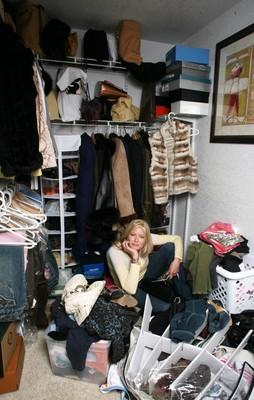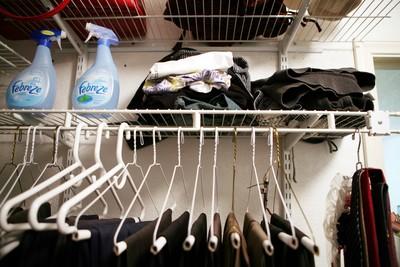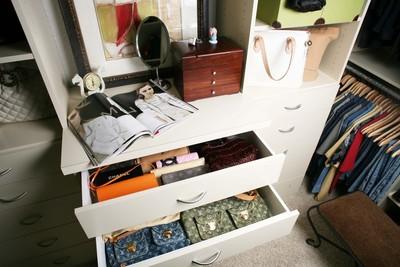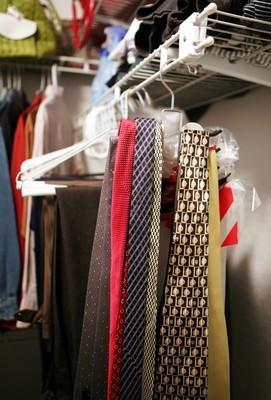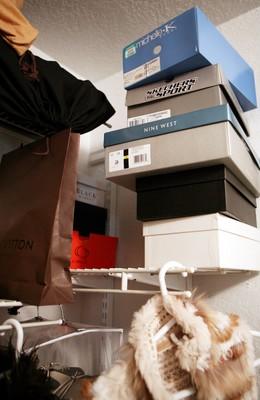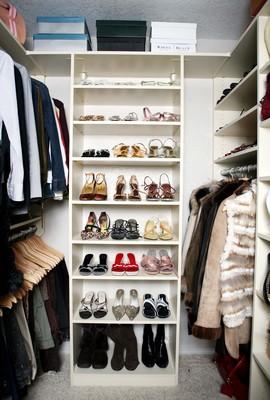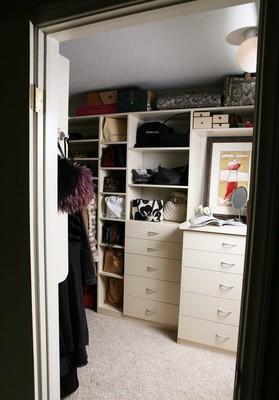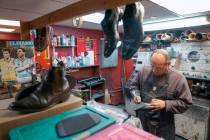Get It Together
Skeletons hide in closets for a reason. When a glimpse into your closet resembles a crime scene investigation -- complete with shirts, pants, skirts, dresses, jackets, belts, hats and shoes strewn everywhere -- you may need more than a little organization. Before you jump into organizing your closet, perhaps the toughest task has to be tackled.
GOOD MOURNING
First steps can be the hardest. In this case, it's making room for your clothes. For some, the process is simple, but for most, it can only be compared to losing a loved one. Purging your closet means getting rid of those stirrup pants and three-sizes-too-small clothes for good.
"A lot of people have a sentimental affection for their wardrobe," said Jenna Doughton, who calls herself a life stylist. "For different people, there are different triggers."
Some of the more common triggers, which Doughton rebuffs, include:
Inheritance: Your grandmother's pearls are one thing. Your grandmother's moth-bitten cardigan is another.
Recycled trends: "It might come back but it will never come back the same way," Doughton said.
Weight loss: Keeping a pair of pants you now drown in just to revel in your accomplishment is pointless; that's what your new birthday suit is for.
Hope for weight loss: Your favorite pair of skinny jeans is likely bringing you much more sorrow than joy.
Love: He might love that little number you despise in the back of your closet but, in the words of Janet Jackson, what has he done for you lately?
Cost: You spent a lot on it. Why not just waste your money rather than waste your space, too?
A lot of people need guidelines to help them empty their closets. If it hasn't been worn in two years, it's automatically out. No excuses. If it's been a year but a second pair of eyes (Doughton recommends a close friend) can find a justification for keeping it, the item is saved.
WHAT'S IN STORE
Once your closet has been purged of unnecessary items, it's time to start properly storing the remainders. No one system will work for everyone, which is why California Closets makes a point of finding out exactly how clients prioritize their wardrobes. If crisp shirts and tailored jackets make up a large portion of the closet, jeans and T-shirts will likely be tucked away during the reorganization.
Your needs will ultimately determine how clothing is stored. If you frown on horizontal creases in pant legs, your pants will require a long hanging space. If you regularly wear hats, a hat box stored up high in the closet won't work. If you don a new purse with every outfit, hanging them on hooks on the walls or using their dust bags to store them for a boutique-like display (as Doughton does) will probably suit you best.
The placement of items determines good organization. "People want to be more organized because their time is precious," said Megan Huegel, co-owner of the Las Vegas franchise of California Closets. "If you're not organized, you're probably wasting a lot of time."
Sorting can be just as crucial as placement. Clothes can be sorted in ready-to-go outfits; styles (casual, business, etc.) or the order in which they are selected every morning (shirts on the far right, then pants, etc.).
Probably the most common way of sorting clothes and the one Doughton swears by is colorizing. "It forces you to look through everything so you remember what you have on a regular basis," she said of the sorting system that begins with white and ends with black.
If your weight tends to fluctuate, you can also sort according to size by placing small sizes on the left side of the closet, mediums in the center, large sizes on the right.
SEE IT TO BELIEVE IT
Making the most of your closet space and ensuring that you will actually wear everything in it means that you have to see everything you own. "Any time you fold something or put it in drawers, you'll never use it because you can't see it," Doughton said. Drawers should be lightly packed; Doughton notices that clients tend to use only the top five items in drawers.
Also, don't dismiss wall space. Cover a bare wall with some part of your wardrobe. Long necklaces can hang from hooks on the wall so you can see all that you have. Shoes can be placed on the wall in cloth hanging devices. Shelves can store items that can't hang, such as the bottom five T-shirts that were previously under a stack of other shirts or the little clutch that was hiding behind your hobo bag before you got organized.
Even if items tend to go into hiding, you can make them more visible. Samantha Ratcliffe-D'Arrigo, personal organizer of Straighten Up Professional Organizing, has found a way to ensure everything can be seen no matter how small the closet is. "Take photographs," she said. "It's the best way to take inventory of your things. That way you can't forget what you've got."
Doughton uses the same technique with jewelry that can't be displayed. "You take pictures of the jewelry, one by one, and put them in a scrapbook. When you're getting ready just flip through the book," she said.
Clear storage boxes or those with windows can hold clothes as well. If you like a storage box but it doesn't have a window, make one by cutting a square in one of the sides.
in focus
When one of California Closet's designers organizes a closet, storage is always the first priority. Attractiveness comes in a close second. To make a closet aesthetically appealing, designers create a focal point. "Usually drawers are attractive so we put them in the middle of a closet," Huegel said.
Not all closets are created equal, however. Many don't have room for a set of drawers. In that case, a part of the wardrobe usually takes center stage. One of Huegel's clients, who was particularly proud of her shoe collection, wanted to display her stilettos in a glass case, an exception to the rule.
"Usually you don't want to look at shoes first. They're dusty, dirty and get scuffed so we usually put them on the same wall as the door of the closet. That way it's the last thing you put on and the last thing you see when you walk out," Huegel said.
Doughton takes eye sores out of plain view with baskets. "I have everybody do a basket for tennis shoes and flip-flops," she said. "It makes room for your other nicer shoes."
LESSON LEARNED
Once you've purged and organized your closet, certain things come into perspective. For one, your closet's inventory. With an unorganized closet that's in complete disarray it's hard to see exactly what you have. Once you can see everything, there's usually an inevitable disproportion that you can use to guide your future purchases.
"If you have too many white cotton shirts and not enough of something else, you'll know exactly what to look for when you're shopping and what to avoid," Doughton said.
The local stylist also takes a look at her client's spending habits. "I make everyone figure out how much they spend on clothes," Doughton said. Then, because most of her clients have issues of excess, they go over smarter shopping methods. "We talk about buying less and what they could do with the savings, like buy more high quality things," she said.
Ratcliffe-D'Arrigo makes a point of urging clients to maintain their closets. "You need to revisit your closet as often as you can," she said. "Definitely from season to season." Otherwise another four-hour closet cleaning session -- the time an average closet takes -- is in your future.
If you need additional motivation to maintain the order of your closet, consider the how hectic it was to get dressed before you organized and cleaned. "You don't realize how much (excess stuff) has weighed on you until it's gone," Ratcliffe-D'Arrigo said.
take it away Once you've cleaned out your closet, it's time to donate the clothes you don't need. Consider any of these options, but do not take your old clothes to the nearest trash can. While your closet may have been overflowing, other wardrobes will be happy accept your clothes. California Closets heads to The Shade Tree, where clothes can be used for its workplace re-entry program. Other charitable sources include United Way, Goodwill and Nathan Adelson Hospice. You can also profit from your spring cleaning by taking your gently used goods to Buffalo Exchange, where you can either trade clothes or sell them. Jenna Doughton, life stylist, recommends making a social event out of it. "Call your girlfriends over and make piles of your stuff so they can go through it all," she said. sources Jenna Doughton, life stylist, 569-1008, www.wwybw.com. Consultations are free, call for a quote. California Closets, 891-0000, 7350 Dean Martin Drive, Suite 301, www. californiaclosets.com. Consultations are free, call for a quote. Samantha Ratcliffe-D'Arrigo, 630-2448, www.straighten -up.org. Ratcliffe-D'Arrigo charges $75 an hour with a three-hour minimum. A few helpful tips for your closet cleaning adventures: Samantha Ratcliffe-D'Arrigo, professional organizer, doesn't try to get creative with her storage methods. Rather, she relies on someone else to do it for her. "Containerstore.com has a container for every function you can think of," she said. Ratcliffe-D'Arrigo also relies on www.Ikea.com for items with high function and high style. When it comes to hangers, there's no one pickier than Jenna Doughton, life stylist. "I went on a mission to find the best hanger ever," said Doughton, who cringes at the sight of the plastic ones most people use. "I finally found it. It's wooden with velvet lining and grooves for lingerie." Doughton buys them from a distributor and sells them for $1.75 each in pink and black velvet. She has never seen them in stores. If your space simply wasn't built to accommodate you well, don't be surprised but don't panic either. "Builders rarely address important things in closets," said Megan Huegel, co-owner of the local California Closets. Homes are also being designed with less storage space. Luckily, California Closets specializes in storage and can install everything from shelving units to cupboards and drawers.



